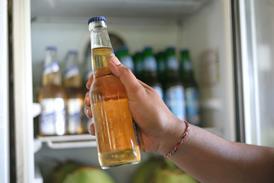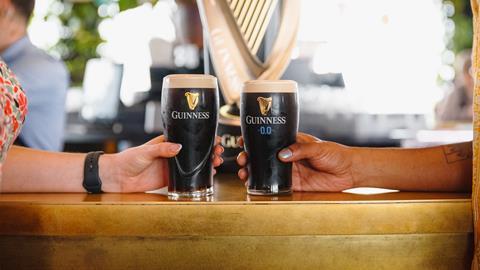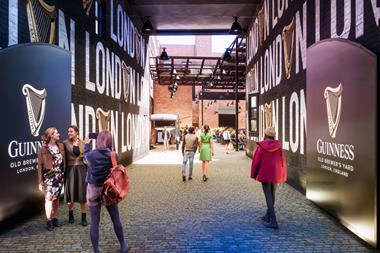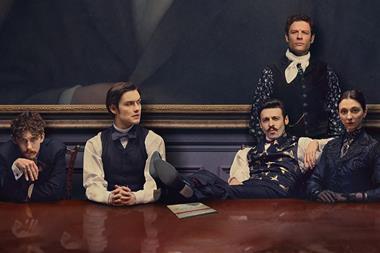They’re a fickle bunch, Gen Z. One day they’re obsessed with ‘splitting the G’ on TikTok, the next they’ve seemingly lost all interest and moved on to BuzzBallz.
That’s one possible reading of the news that the Guinness boom – in the off-trade at least – looks to have come to an end.
After a remarkable post-Covid growth tear that has defied a sluggish beer and cider market and made stout cool again, Guinness’ year-on-year growth figures in the past six and three months make far less positive reading.
While at a brand level Guinness’ value is being propped up by price rises and the success of its alcohol-free Guinness 0.0 variant, Draught is barely growing. Amid the rise of cheaper competitors like BrewDog Black Heart and Murphy’s, the brand is no longer winning share of throat and volumes are firmly on a downward trajectory.
‘Temporary blip’
Guinness owner Diageo insists this is a temporary blip, brought on by a decision to row back on promotional activity in April following a period of “unprecedented demand” that led to fears of shortages and rationing last Christmas.
“This data reflects the temporary pause on Guinness off-trade promotional material earlier this year, a Diageo decision made in response to unprecedented consumer demand in December 2024,” a spokesman for Diageo told The Grocer. “This decision was necessary to ensure maximum availability for our customers and consumers and since resuming promotional activity in August we are pleased that Guinness sales in the off-trade are back in significant growth.”
The term “significant growth” feels like a stretch, given Guinness value sales were up just 4.6% in the four weeks ended 9 August [NIQ]. Plus, it ignores the negative volume trend, which shows shoppers simply aren’t buying Guinness with the same frequency they were this time last year.
Part of this is surely down to price. A 4x440ml pack of Guinness Draught now sells at a pre-promotional price of £5.75 in Tesco, up 17.6% from the £4.89 it cost a year ago [Assosia 52 w/e 13 August 2025].
That kind of inflation-busting pricing is bound to have played a part in shoppers looking elsewhere for their stout fix. Tesco sells BrewDog’s Black Heart for £5.50 per 4x440ml pack, while a four-pack of Murphy’s is cheaper still at £5.
It remains to be seen whether the return of promotional activity can revive Guinness volumes, or whether shoppers have moved on – either to cheaper rivals or ‘the next big thing’ like BuzzBallz.
Long-term trajectory
Take a step back, however, and it’s hard not to be impressed by Guinness’ long-term growth trajectory.
Rewind 10 years and it was a different story, with The Grocer’s Britain’s Biggest Alcohol Brands Report 2015 showing the brand treading water, with sales amounting to just £94.1m [NIQ 52 w/e 26 April 2015]. By the time of this year’s report, Guinness was worth a heady £240.4m, having grown value by an impressive 155% over the decade [NIQ 52 w/e 19 April 2025].
It would be easy to attribute this turnaround to recent social media trends and endorsements from celebrities like Olivia Rodrigo and Kim Kardashian. But the truth is Diageo’s smart, long-term investment has allowed it to rebuild and reshape the brand’s image.
Historically, the stout relied on big-budget TV advertising and associations with rugby’s Six Nations tournament to drive sales. In more recent times, however, innovation such as Guinness 0.0 and Nitrosurge, new partnerships with the Premier League and a greater emphasis on digital and experiential marketing have been part of a concerted effort to broaden its appeal.
“Guinness has been built on four pillars: heritage, quality, brand identity/meaning and innovation,” wrote Bernstein analysts in a recent note to clients. “The core of its success has been to constantly reinterpret these pillars to appeal to new generations of drinkers.
“In particular, this has been underpinned by truly thought-provoking, relevant advertising campaigns, supported by constant innovation, most recently Guinness 0.0.”
As a result, Guinness brand penetration among younger legal drinking age and female consumers is the highest it has ever been. So is its share in the on-trade, where it accounts for one in every nine pints consumed [CGA].
Chameleon-like reinvention
“What is incredibly impressive is how Guinness has succeeded in making itself relevant for multiple new generations of drinkers,” the Bernstein analysts continue. “It has not been an uninterrupted growth curve; but the long-term trajectory is clear.”
Next month, Netflix is debuting a new biopic titled ‘House of Guinness’. Created by Steven Knight, the man behind Peaky Blinders, the historical drama will tell the story of the events following the death of Sir Benjamin Guinness – grandson of the famous Arthur Guinness – in 1868.
Meanwhile, Diageo is itself preparing to open the eagerly-awaited (and delayed) £73m ‘Guinness at Old Brewer’s Yard’ venture in Covent Garden before the end of the year. Both should help ensure the brand remains talked about well into 2026, at least.
But if volumes keep sliding, Guinness may need to tap once again into its chameleon-like knack for reinvention to stay relevant.

























No comments yet